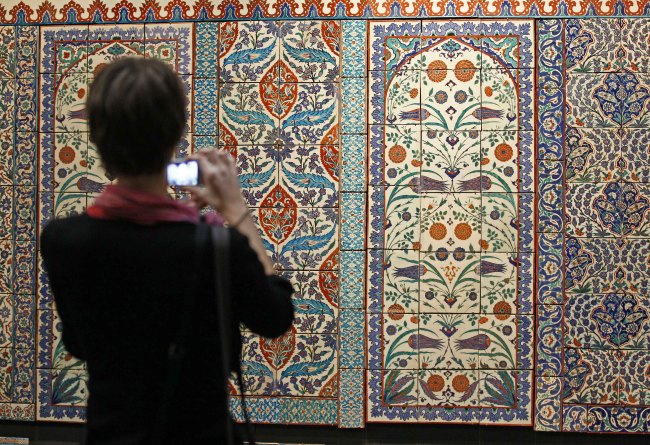PARIS (AP) ― In its boldest development in a generation, the Louvre
Museum has a new wing dedicated to Islamic art, a nearly 100 million
$130 million project that comes at a tense time between the West and the
Muslim world.
Louvre curators tout their new Islamic Art department, which took 11 years to build and opens to the public on Saturday, as a way to help bridge cultural divides. They say it offers a highbrow and respectful counterpart to the recent unflattering depictions of the Prophet Muhammad in Western media that have sparked protests by many Muslims.
 A member of the media takes snapshots of a ceramic tile wall displayed at the Louvre Museum in Paris, Sept. 20.
A member of the media takes snapshots of a ceramic tile wall displayed at the Louvre Museum in Paris, Sept. 20.
Still, one of the Louvre’s own consultants acknowledged that some Muslims could be “shocked’’ by three images of Muhammad with his face exposed in the new wing. Many Muslims believe the prophet should not be depicted at all ― even in a flattering way ― because it might encourage idolatry.
The galleries provide a needed showcase one of the West’s most extensive Islamic art collections, some 18,000 artifacts that range from the 7th century to the 19th century.
But the wing does not dwell on the old: It is housed under a futuristic, undulating glass roof designed by architects Rudy Ricciotti and Mario Bellini that has garnered comparisons to a dragonfly wing, a flying carpet, even a wind-blown veil. It marks the Louvre’s biggest change since I.M. Pei shook up the famed Paris museum with his iconic glass pyramid in 1989.
France, meanwhile, is bracing for possible disruptions at embassies across the Muslim world on Friday after the French satirical weekly Charlie Hebdo published lewd caricatures of Muhammad on Wednesday. The publication raised concerns that French interests could face violent protests like the ones targeting the United States over a video produced in California that ridiculed the prophet. Those protests, which continued on Thursday, have left at least 30 people dead.
But could the new museum wing actually be good timing?
The Louvre collection’s mission is to foster understanding between the West and the Islamic world. Instead of highlighting Islam as one united religion, it celebrates the secular, tolerant and cultural aspects of different Islamic civilizations.
Sophie Makariou, head of the Louvre’s Islamic art department, hopes the new wing will teach lessons about tolerance and diversity.
Louvre curators tout their new Islamic Art department, which took 11 years to build and opens to the public on Saturday, as a way to help bridge cultural divides. They say it offers a highbrow and respectful counterpart to the recent unflattering depictions of the Prophet Muhammad in Western media that have sparked protests by many Muslims.
 A member of the media takes snapshots of a ceramic tile wall displayed at the Louvre Museum in Paris, Sept. 20.
A member of the media takes snapshots of a ceramic tile wall displayed at the Louvre Museum in Paris, Sept. 20.Still, one of the Louvre’s own consultants acknowledged that some Muslims could be “shocked’’ by three images of Muhammad with his face exposed in the new wing. Many Muslims believe the prophet should not be depicted at all ― even in a flattering way ― because it might encourage idolatry.
The galleries provide a needed showcase one of the West’s most extensive Islamic art collections, some 18,000 artifacts that range from the 7th century to the 19th century.
But the wing does not dwell on the old: It is housed under a futuristic, undulating glass roof designed by architects Rudy Ricciotti and Mario Bellini that has garnered comparisons to a dragonfly wing, a flying carpet, even a wind-blown veil. It marks the Louvre’s biggest change since I.M. Pei shook up the famed Paris museum with his iconic glass pyramid in 1989.
France, meanwhile, is bracing for possible disruptions at embassies across the Muslim world on Friday after the French satirical weekly Charlie Hebdo published lewd caricatures of Muhammad on Wednesday. The publication raised concerns that French interests could face violent protests like the ones targeting the United States over a video produced in California that ridiculed the prophet. Those protests, which continued on Thursday, have left at least 30 people dead.
But could the new museum wing actually be good timing?
The Louvre collection’s mission is to foster understanding between the West and the Islamic world. Instead of highlighting Islam as one united religion, it celebrates the secular, tolerant and cultural aspects of different Islamic civilizations.
Sophie Makariou, head of the Louvre’s Islamic art department, hopes the new wing will teach lessons about tolerance and diversity.
 Detail of Andy Warhol's portrait of the Queen
Detail of Andy Warhol's portrait of the Queen